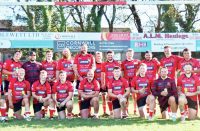Brendan Gallagher delves into some of rugby’s most enduring images, their story and why they are still so impactful

What’s happening here?
It’s August 16, 1958 and France are playing the Springboks at Ellis Park in the second Test of their first ever tour of South Africa; in fact their first overseas tour of any description. The man in possession was not named by photographer Philippe LeTellier, who along with L’Equipe’s Denis Lelanne accompanied the tour, but is almost certainly Paris University right wing Guy Stener.
What’s the story behind the picture?
After many false starts this was the tour and indeed the game when France truly announced themselves as a major force in World Rugby. Up until this juncture they were generally viewed as interesting and talented mavericks – albeit often badly behaved in the sense of flouting professionalism rules – who were too inconsistent and flaky on the pitch to trouble the very best on a regular basis.
But 1958 brought a sea change even though an auspicious year didn’t start particularly well. After being whitewashed in the 1957 Five Nations, Les Bleus opened up their next campaign with another two defeats but then, under the captaincy of lock Michel Celaya and then Maurice Prat, they won the final two games of the tournament against Wales and Ireland.
They then beat an obdurate Italy 11-3 in Naples in an end-of-season Test for the selected South African tour party. As it happens Prat couldn’t tour and Celeya was succeeded as captain by athletic lock Lucian Mias, an inspired appointment.
It was a tough quick-fire ten-match tour but, confounding those who expected the ‘flaky’ French to go AWOL, Les Bleus stuck to their task, became fitter and more disciplined and saved their best rugby for the two Tests. There were three defeats – against Northwest Transvaal the Junior Springboks and a curiously hybrid team from Western Province,
Boland and the South West Districts but Les Bleus stunned the South African public by forcing a fighting 3-3 draw in the first Test in Cape Town when a dropped goal from diminutive scrum-half Pierre Danos earned them a share of the honours.
Suddenly the second Test was a series decider and France took their unexpected chance ruthlessly, making light of the altitude of Johannesburg after a month down at sea level. They took on and bettered the fearsome Boks pack and, after tailing just 5-3 at half-time, replied with two second-half dropped goals from Roger Martine and Pierre Lacaze who had also kicked the France penalty. Rather unexpectedly they had become the first team to win a series in South Africa in the 20th century, something that had proved beyond the Lions, New Zealand and Australia.
What happened next?
The first and still one of the greatest golden ages of French rugby. Having beaten the Boks, France kicked on in spectacular fashion in the next four seasons winning three Five Nations Championships outright and sharing a fourth in 1960. And on top of that, this tour spawned one of the great rugby books and certainly one of the best tour books in history from Lelanne with his mate LeTellier providing the pictures. Le Grand Combat du Quinze de France or the Great Fight of the French XV still stands the test of time.
Curiously he decided to write only about 1958 after he had penned another very readable tour book – La Melee Fantastique – which chronicled France’s first ever tour to New Zealand in 1961. That proved a best seller and Lelanne then realised he had an even better tale to tell from their visit to South Africa four years earlier. An eloquent man with a wideranging interests, he gave full vent to describe this fascinating pioneering tour.
English reprints are rare but they do appear occasionally while a few years back a dramatised documentary/film of the tour leaning heavily on the book appeared on French TV.
Why is the picture iconic?
This image ticks all sorts of boxes. Massive infinitesimal African skies, blazing sunshine, parched corn white ground, sizzling heat. The climate and venues – especially in August – were as uncompromising as the Boks. As you view the image you can almost hear the clatter of studs on the hard ground and smell the sunscreen and the brais round the back of the wooden stands. Being black and white if anything adds to the timeless quality of the picture.
Then there is the dynamic action. The right wing Stener is flat out going for the outside but is also dipping his left shoulder for the inevitable contact from the Boks’ tackler. It feels close to the line, you sense he should probably score but we know France didn’t score a try that day so exactly how did this mano a mano resolve itself ?A tantalising unspoken question mark hangs over this picture. What did happen next?
Footnote: This was the last of just five Tests Stener played, one of the few players from the class of 58 who didn’t crack on. At one stage he moved to London and played briefly for Harlequins and after retiring from playing he died prematurely in 1967 aged 37.
























Pingback: find out this here